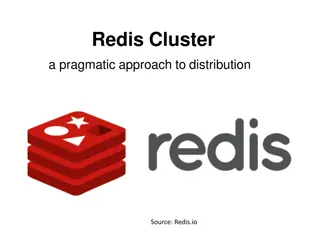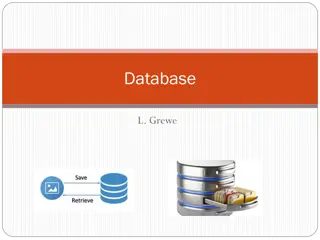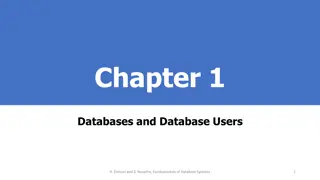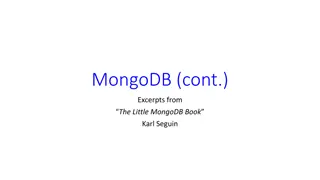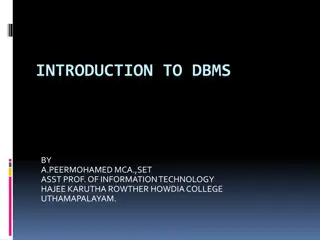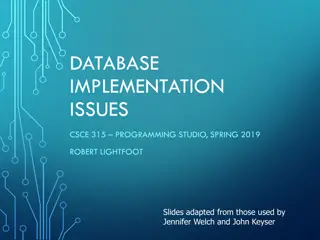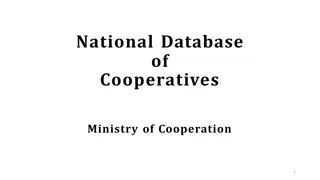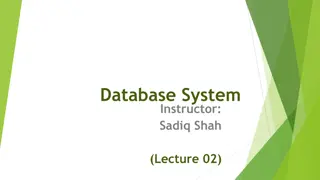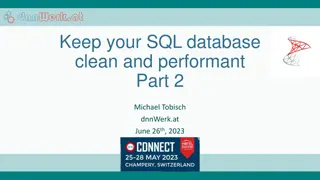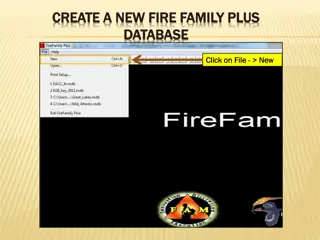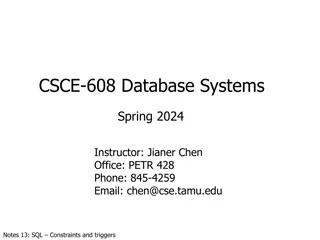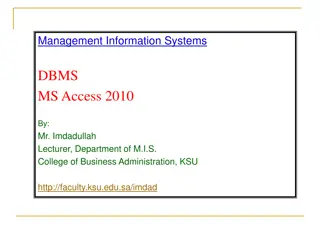Understanding Redis: A Key-Value NoSQL Database Overview
Redis is a flexible in-memory data structure store that acts as a database, cache, and message broker. It follows a key-value store principle, offering various data structures like strings, lists, sets, and more. Redis allows users to store a large amount of data without the limitations of relational databases. The architecture includes two main processes: Redis Client and Redis Server, which can be on the same or different computers. Different data types like strings, lists, and sets are explained along with their commands and functionalities in Redis.
Download Presentation

Please find below an Image/Link to download the presentation.
The content on the website is provided AS IS for your information and personal use only. It may not be sold, licensed, or shared on other websites without obtaining consent from the author. Download presentation by click this link. If you encounter any issues during the download, it is possible that the publisher has removed the file from their server.
E N D
Presentation Transcript
Introduction to Redis CS237 Presentation Group 5 Qirui Yang Mingyuan Yang Jiannan Tan
what is Redis? 01 Redis is a NoSQL database which follows the principle of key-value store. The key-value store provides ability to store some data called a value, inside a key. You can recieve this data later only if you know the exact key used to store it. Redis is a flexible, open-source (BSD licensed), in-memory data structure store, used as database, cache, and message broker. Redis is a NoSQL database so it facilitates users to store huge amount of data without the limit of a Relational database. Redis supports various types of data structures like strings, hashes, lists, sets, sorted sets, bitmaps, hyperloglogs and geospatial indexes with radius queries.
01 what is Redis? Redis Architecture There are two main processes in Redis architecture: (1) Redis Client (2) Redis Server These client and server can be on same computer or two different computers.
02 Data Structure types Redis allows us to store keys that map to any one of five different data structure types: STRING, LIST, SET, HASH, and ZSETs.
02 Data Structure types Strings in Redis In Redis, STRINGs are similar to strings that we see in other languages or other key-value stores. Generally, when I show diagrams that represent keys and values, the diagrams have the key name and the type of the value along the top of a box, with the value inside the box. Command used on STRING values Command What it does Fetches the data stored at the given key Sets the value stored at the given key Deletes the value stored at the given key (works for all types) GET SET An example of a STRING, world, stored under a key, hello DEL
02 Data Structure types Lists in Redis In key-value stores, Redis is unique in that it supports a linked-list structure. LISTs in Redis store an ordered sequence of strings, and like STRINGs. Command used on LIST values Command What it does Pushes the value onto the right end of the list Fetches a range of values from the list RPUSH LRANGE Fetches an item at a given position in the list LINDEX An example of a LIST with three items under the key, list-key Pops the value from the left end of the list and returns it LPOP
02 Data Structure types In Redis, SETs are similar to LISTs in that they re a sequence of strings, but unlike LISTs, Redis SETs use a hash table to keep all strings unique (though there are no associated values). Because Redis SETs are unordered, we can t push and pop items from the ends like we did with LISTs. Instead, we add and remove items by value with the SADD and SREM commands. We can also find out whether an item is in the SET quickly with SISMEMBER, or fetch the entire set with SMEMBERS (this can be slow for large SETs, so be careful). Sets in Redis Commands used on SET values Command What it does SADD Adds the item to the set SMEMBERS Returns the entire set of items An example of a SET with three items under the key, set-key SISMEMBER Checks if an item is in the set Removes the item from the set, if it exist SREM
02 Data Structure types Hashes in Redis Redis HASHes store a mapping of keys to values. The values that can be stored in HASHes are the same as what can be stored as normal STRINGs: strings themselves, or if a value can be interpreted as a number, that value can be incremented or decremented. Command used on HASH values Command What it does Stores the value at the key in the hash HSET Fetches the value at the given hash key HGET HGETALL Fetches the entire hash Removes a key from the hash, if it exists HDEL An example of a HASH with two keys/values under the key, hash-key
Data Structure types 02 Like Redis HASHes, ZSETs also hold a type of key and value. The keys (called members) are unique, and the values (called scores) are limited to floating-point numbers. ZSETs have the unique property in Redis of being able to be accessed by member (like a HASH), but items can also be accessed by the sorted order and values of the scores. Zsets in Redis Command used on ZSET values Command What it does Adds member with the given score to the ZSET Fetches the items in the ZSET from their positions in sorted order Fetches items in the ZSET based on a range of scores Removes the item from the ZSET, if it exists ZADD ZRANGE ZRANGEBYSCORE ZREM An example of a ZSET with two members/scores under the key, zset-key
03 Principle Redis is a Key-Value memory database. All the data is stored in memory in the form of key/value 1. put all the data in memory The speed of disk I/O seriously affects redis performance if data is not stored in memory 2.Single thread If there is only one thread, processing requests in memory can be quick without context switching
03 Principle Multiple requests may produce different operations concurrently, but IO multiplexers listen to multiple requests , queue the events, and the event dispatcher takes one event from the queue at a time and hands the event over to the corresponding event processor for processing.
Principle 03 The data is in memory. Once server is restarted, the data disappears. We need to back it up to disk 1. RDB Redis will build a snapshot of database 2.AOF Redis will store how we operate database in AOF files
04 Compared with Memcached 1.Redis not only supports key/value types of data, but also provides more data structures such as list,set,zset,hash. 2.Redis support that the data in memory can be kept on disk and can be reloaded when rebooted. 3.Memcached is multithreading, resulting in performance losses; Redis use single thread and fast speed 4.Redis can realize master-slave replication and data recovery
Redis use cases 05 1. Session cache One of the most apparent use cases for Redis is using it as a session cache. The advantage of using Redis over other session stores, such as Memcached, is that Redis offers persistence. While maintaining a cache isn t typically mission- critical with regards to consistency, most users might be upset if all their cart sessions go away. 2. Full-page cache Outside of your basic session tokens, Redis provides a straightforward Full-page cache (FPC) platform in which to operate. Consistency factors here, too. Even across restarts of Redis instances, with disk persistence, your users don t see a decrease in speed for their page loads a drastic change from something similar to PHP native FPC. 3. Leaderboards and counting Redis does a great job with increments and decrements because it s in-memory. Sets and sorted sets also make our lives easier when we do these kinds of operations. Redis just so happens to offer both of these data structures. 4. Publish-Subscribe Redis has a Publish-Subscribe (Pub/Sub) feature. The use cases for Pub/Sub are boundless. I ve seen people use it for social network connections, for triggering scripts based on Pub/Sub events, and even for a chat system built using Redis Pub/Sub.


